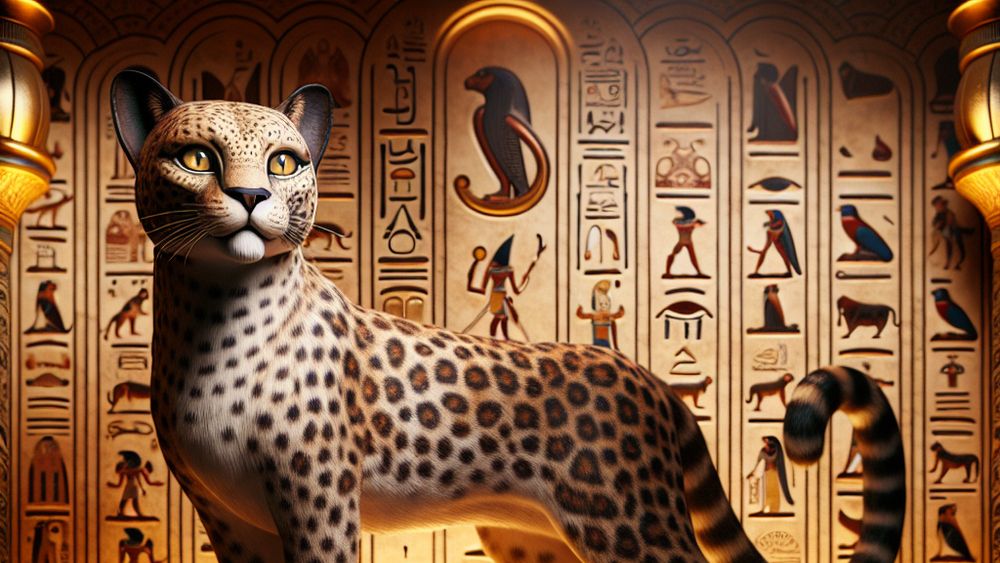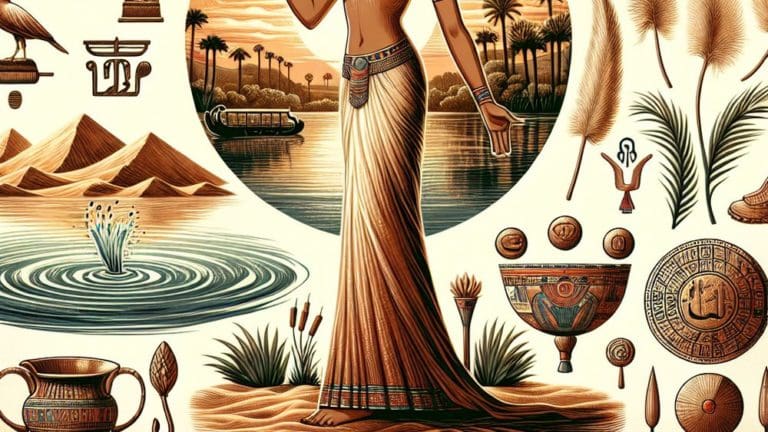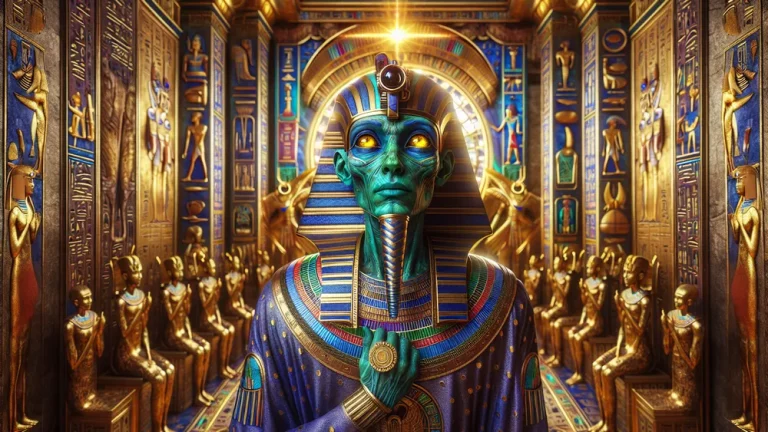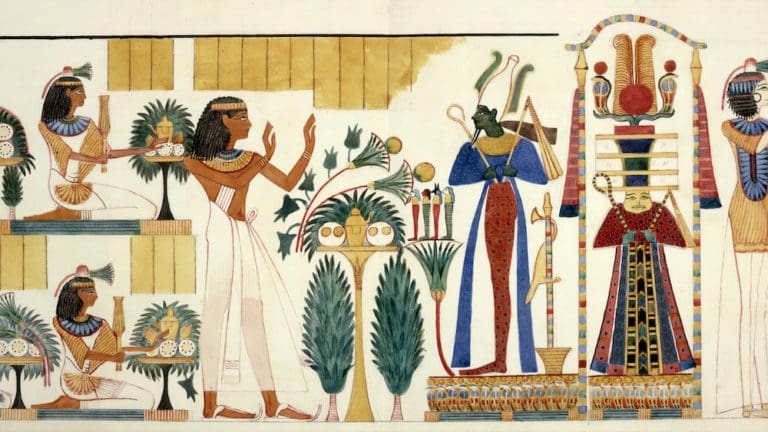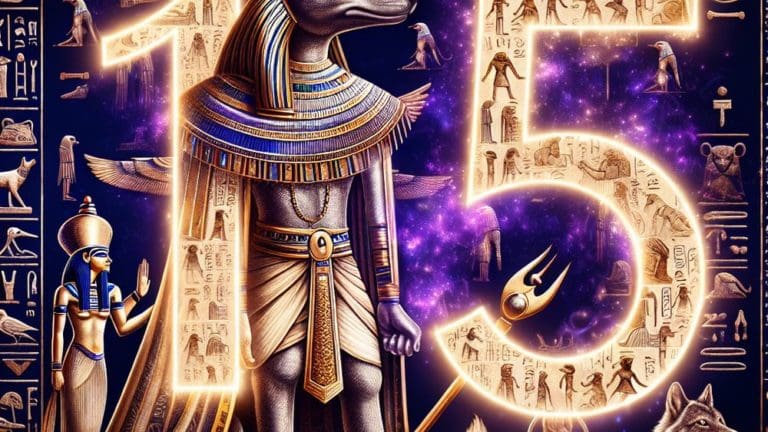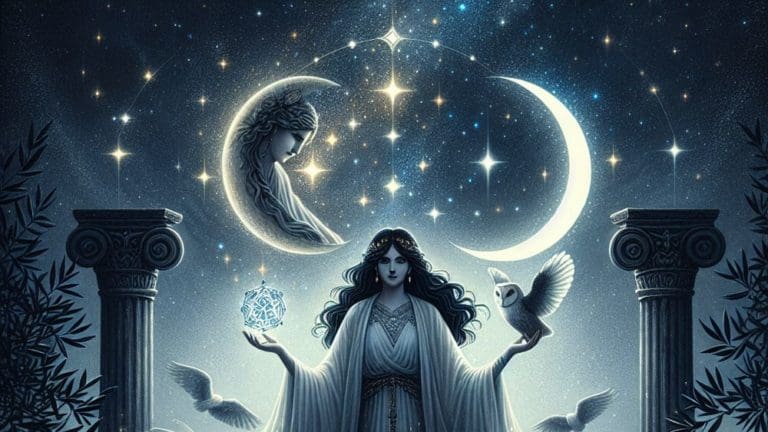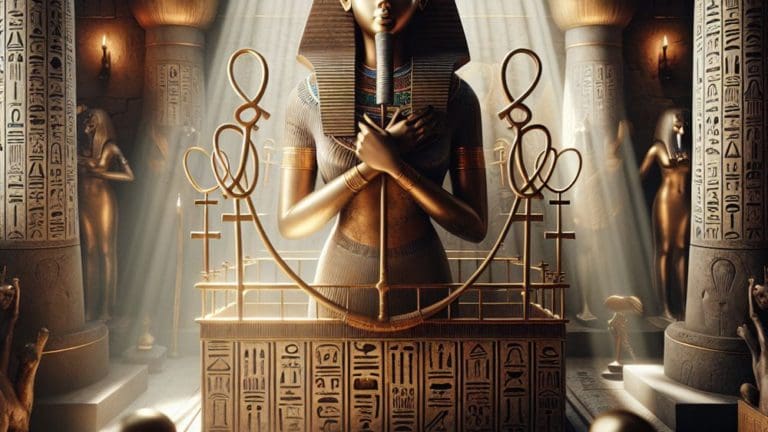Mafdet: The Feline Guardian – Egyptian God Mafdet
Mafdet: The Feline Guardian – Egyptian God Mafdet
Have you ever wondered about the mysteries that shroud ancient Egyptian deities? Among these captivating divinities, the Egyptian god Mafdet marks her exceptional stand. This fascinating feline guardian, often shadowed by more prominent gods and goddesses, holds the keys to understanding ancient Egypt’s profound and complex belief systems. Curiosity beckons us to delve into her story, a tale steeped in protection, justice, and the sacred duty of defending the pharaohs.
Key Points:
- Mafdet is an ancient Egyptian goddess known as the feline guardian.
- She symbolizes protection, justice, and defense of the pharaohs.
- Mafdet’s iconography includes a cheetah head, a scepter, and a rope.
- She played a crucial role in maintaining cosmic balance and upholding Maat.
- Mafdet’s worship involved rituals for protection against evil and injustice.
- Her legacy influenced later feline goddesses despite the decline of her cult.
- Mafdet’s mythology portrays her as a swift and powerful protector against chaos.
Mafdet, the cheetah-headed goddess, embodies the essence of swiftness and deadly precision. Her origins trace back to the first dynasty of Egypt, setting the stage for a rich tapestry of cultural and religious evolution. Through the artefacts, hieroglyphs, and ancient texts, we catch glimpses of her role and significance. Join us on this journey as we unravel the enigma of Mafdet, exploring her myths, worship, and enduring legacy in the annals of history.
Unveiling Mafdet: The Protector in Early Egyptian Mythology
In the sprawling pantheon of Egyptian deities, Mafdet holds a unique place as the protector deity, embodying the qualities of justice, swiftness, and protection against venomous creatures. Her veneration speaks volumes about the ancient Egyptians’ values and their deep connection with the animal kingdom, highlighting the goddess’s role in their daily and spiritual lives.
Origins and Historical Context of Mafdet
Mafdet’s origins are as mystifying as they are ancient, stretching back to the first dynasty of Egypt. This remarkable longevity makes her one of the earliest deities worshipped in the Nile valley. Historians suggest that Mafdet’s role evolved over centuries, initially revered as a protector of the royal household and an avenger of the king. This connection to the pharaohs underscores the profound importance of divine protection in the maintenance of Maat or cosmic order, which the pharaohs were deeply intertwined with.
By exploring archaeological finds and ancient texts, scholars have pieced together Mafdet’s significance in early Egyptian society. Her depictions in early dynastic period artefacts convey a deeply rooted belief in her power to safeguard and avert evil. Through Mafdet, we glimpse the Egyptians’ intricate relationship with their gods and goddesses, a testament to their quest for balance and protection in the unpredictable currents of life.
Mafdet’s ancient origins and evolving role as a protector of the royal household highlight the Egyptians’ deep belief in divine protection and maintaining cosmic order.
Mafdet’s Iconography and Symbolism
Mafdet’s iconography is as fierce and elegant as the feline creatures she is associated with. Often depicted with the head of a cheetah or a lioness, her imagery embodies the qualities of agility, strength, and swift justice. These representations were not only symbolic but also an invocation of her protective qualities against venomous bites and the enemies of the state.

| Symbol | Representation |
|---|---|
| Cheetah Head | Swiftness, agility, and sharp judgment |
| Scepter | Authority and protection of laws |
| Rope | Binding of evil forces and protection of the household |
Through these symbolic representations, the ancients communicated Mafdet’s multifaceted role in their lives, intertwining her divine essence with the mortal realm’s daily challenges and fears.
The Role of Mafdet in Ancient Egyptian Religion
Mafdet played a critical role in ancient Egyptian religion as a guardian deity, protecting the pharaohs and their subjects from physical and metaphysical threats. Her veneration was closely linked with the notions of justice and order, embodying the concept that the divine played a direct part in maintaining the cosmic balance or Maat. Such beliefs placed Mafdet at the heart of the judicial system, symbolizing the swift and decisive nature of divine retribution against wrongdoing.
In rituals and religious texts, Mafdet was frequently invoked to safeguard against venomous creatures, exemplifying her as a protector of homes and temples from unseen dangers. Moreover, as an avenger of the king, Mafdet’s presence was believed to fortify the pharaoh’s authority, ensuring his ability to uphold Maat. Her worship underscores the intrinsic link between deity veneration and the state’s wellbeing, a connection that forged the backbone of ancient Egyptian societal norms and beliefs.
Mafdet’s role in ancient Egyptian religion symbolized the direct involvement of the divine in upholding justice, order, and cosmic balance, emphasizing the importance of deity worship in maintaining societal harmony and the state’s wellbeing.
Mafdet’s Associations with Justice and Kingship
Mafdet’s enduring legacy in Egyptian mythology is intricately tied to her associations with justice and kingship. As both a protector of the pharaohs and an avenger of their enemies, her divine influence extended beyond the spiritual realm, shaping the very foundations of ancient Egyptian law and governance.
The Connection Between Mafdet, Maat, and the Pharaoh
The connection between Mafdet, Maat, and the Pharaoh is profound, as it unifies the concepts of divine protection, cosmic order, and royal authority. Mafdet, embodying the swift hand of justice, served as the pharaohs’ celestial avenger, reinforcing their divine right to rule and maintain Maat. This sacred triad underscores the pivotal role of gods and goddesses in legitimizing and empowering the pharaohs, ensuring their actions aligned with the divine will to uphold balance and order within the kingdom.
This divine endorsement provided an essential religious framework that validated the pharaoh’s sovereign power, highlighting the intricate blend of religion, politics, and law that characterized ancient Egyptian society. Through her association with Maat, Mafdet symbolized not just the protection of the pharaohs but also the broader concept of order and justice that permeated every aspect of daily life and governance.
Mafdet’s Influence on Law and Order in Ancient Egypt
Mafdet’s influence on law and order in Ancient Egypt was profound and emblematic. With her role as the avenger of the king and a symbol of protection, she embodied the essence of justice and order. Her association with the pharaohs bolstered the concept that justice was indivisible from the crown, ensuring that her reach extended to all aspects of Egyptian society.
The significant impact Mafdet had on legal practices and the enforcement of law was clear. She was venerated not just as a deity of physical strength but as an eternal guardian of moral and legal order.
- Mafdet was seen as an enforcer of Maat, the concept of truth, balance, order, harmony, law, morality, and justice in Egypt.
- Her depictions often showed her executing serpents or other creatures that posed a threat, symbolizing her protection against evil and injustice.
- Pharaohs and officials might invoke Mafdet’s name in legal decrees, seeking her backing to legitimize their rulings.
- Inscriptions and artifacts reflect her status as the protector of the royal house and the justice system, underlining her integral role in maintaining cosmic order.
Stories and Myths Surrounding Mafdet
Mafdet’s lore is steeped in her prowess and her unwavering role as a protector, embodying the spirit of justice and vengeance. Her tales, passed down through generations, highlight her as a formidable force against evil.
Her mythology painted her as not just a guardian of the pharaohs but also as a defender of the common people, always ready to strike down upon any form of injustice.
- One of the most potent symbols of Mafdet’s protection was her role in defeating a serpent, which represented chaos and evil.
- In another tale, she is said to have protected the sun god Ra, demonstrating her immense power and her critical role among the gods.
- Ancient texts occasionally reference Mafdet sprinting along the heads of the gods, a portrayal emphasizing her swift justice.
- Her stories often illustrate Mafdet’s speed, likening her to a cheetah, which was one of her most iconic representations.
Mafdet’s tales emphasize her as a powerful protector against evil, embodying justice and swift justice akin to a cheetah.
The Worship and Cult of Mafdet
The worship and cult of Mafdet reflect the ancient Egyptians’ profound admiration and reverence for her. This nonsectarian veneration highlighted her significance across various epochs, particularly during the first dynasty of Egypt, as both protector and avenger of the king.
Rituals and Ceremonies Dedicated to Mafdet
Rituals and ceremonies dedicated to Mafdet often involved offerings and prayers for protection against serpents and other creatures symbolic of chaos and evil. Her followers sought her blessings for justice and protection in both royal courts and daily life, hoping to embody the values she represented.

Temples and Shrines: The Centers of Mafdet’s Worship
Temples and shrines dedicated to Mafdet, though not as abundant as those for other goddesses, played a central role in her worship. They were the epicenters of spiritual life and justice, serving as places for her devotees to connect with her divine protection.
- The Temple of Mafdet at Bubastis was a key site, where rituals and celebrations in her honor were conducted with great fervor.
- Various artifacts and depictions of Mafdet have been found in different parts of Egypt, pointing to a widespread, albeit focused, worship.
- Shrines dedicated to her, often featured images of Mafdet sprinting atop the heads of her enemies, symbolizing her role as a protector.
Temples and shrines dedicated to Mafdet were central to her worship, serving as hubs for divine protection and justice, emphasizing her role as a protector.
The Decline and Legacy of Mafdet’s Cult
The decline of Mafdet’s cult began as other deities, such as Bastet and Sekhmet, rose to prominence. Despite this, her legacy persisted, influencing later representations and roles of feline goddesses within the Egyptian pantheon.
Her attributes, particularly her association with justice and protection, were integrated into the worship of these succeeding goddesses, ensuring that her essence lived on. Even today, her depiction as a cheetah-headed goddess, emblematic of swift justice, continues to inspire fascination and admiration among scholars and followers of Egyptian mythology.
Her legacy also serves as a testament to the fluidity of religious worship in ancient Egypt, where the roles and characteristics of gods could evolve yet remain integral to the culture’s core values.
FAQs
1. What symbols are commonly associated with Mafdet?
The symbols commonly associated with Mafdet include the head of a cheetah or a lioness, signifying her prowess and agility. She is often depicted with a knife or scepter, symbolizing her role as a protector and avenger, particularly against venomous creatures and enemies of the pharaoh.
2. How did Mafdet’s role in Egyptian mythology differ from that of other deities?
Mafdet’s role in Egyptian mythology was distinct as she was one of the earliest known deities providing protection from venomous bites and justice. Unlike other goddesses, Mafdet’s focus was on swift and decisive actions against wrongdoing, embodying the concept of avenger of the king and protector of the sacred.
3. Are there any surviving temples dedicated to Mafdet?
Currently, there are no known surviving temples solely dedicated to Mafdet, reflecting the ancient nature of her worship and the evolution of Egyptian religious practices. However, her presence and worship may be inferred through images and mentions within broader religious sites from the first dynasty of Egypt.
4. How has Mafdet influenced modern perceptions of ancient Egyptian religion?
Mafdet has influenced modern perceptions of ancient Egyptian religion by highlighting the civilization’s early focus on protection and justice, as well as the integral role of feline deities. Her attributes have contributed to the understanding of the multifaceted nature of Egyptian gods and goddesses, including their association with the pharaohs and the concept of divine justice.
Conclusion
In the wondrous tapestry of ancient Egyptian deities, Mafdet stands out as a feline guardian, embodying the principles of protection, justice, and swift retribution. Her symbolism, deeply intertwined with the pharaohs and the righteousness of Maat, continues to fascinate us, shedding light on the rich cultural and religious fabric of early Egypt. The legacy of the Egyptian god Mafdet captivates the hearts of history enthusiasts, travelers, and scholars, inviting us to delve deeper into the mysteries of the past and appreciate the intricate relationships between the divine and the mortal. Thank you for joining me on this extraordinary journey of discovery. I hope it has sparked in you the same curiosity and admiration for the ancient world that drives me. Let’s continue to explore the unveiled secrets and stories that await us in the whispering sands of time.
Warm wishes,
Cedric

